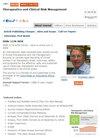Time in Therapeutic Range of Unfractionated Heparin-Based Therapy in Critically Ill Patients with COVID-19 Pneumonia
IF 2.8
3区 医学
Q1 Pharmacology, Toxicology and Pharmaceutics
引用次数: 0
Abstract
Purpose: Anticoagulation therapy aims to improve the outcome of critically ill patients with severe COVID-19-associated pneumonia. Activated partial thromboplastin time (aPTT) is commonly used to maintain the target therapeutic range of continuous infusion of unfractionated heparin (UFH). The UFH infusion efficacy can be evaluated by determining the time in therapeutic range (TTR) using a modified Rosendaal method. The present study’s primary aim was to evaluate TTR based on the aPTT in critically ill patients with severe forms of COVID-19 pneumonia and its influence on survival. The secondary aim was to evaluate the time spent above (TATR) and below the therapeutic range (TBTR).Patients and Methods: We performed a retrospective analysis of critically ill patients with COVID-19-associated pneumonia. All patients received a continuous infusion of UFH from the 2nd to 8th day since admission to the ICU. TTR, TATR, and TBTR were calculated using the modified Rosendaal method, and survival days were analyzed by regression (censored after 60 days).
Results: Of 103 patients, the median TTR was 49% (IQR 38– 63%), TATR 11% (IQR 5– 20%), and TBTR 33% (IQR 22– 51%). The regression analysis indicated a positive impact of higher TTR and TATR on the number of survival days [β=0.598 (p=0.0367) and β=1.032 (p=0.0208), respectively] and a negative impact of higher TBTR [β=− 0.681 (p=0.0033)] on the number of survival days.
Conclusion: Higher TTR and TATR were associated with better survival of critically ill patients with a severe course of COVID-19-associated pneumonia. Higher TBTR was associated with worse survival in these patients.
Keywords: unfractionated heparin, COVID-19, pneumonia, critical care
COVID-19 肺炎重症患者接受非减量肝素治疗的治疗范围时间
目的:抗凝疗法旨在改善重症 COVID-19 相关肺炎患者的预后。活化部分凝血活酶时间(aPTT)通常用于维持持续输注非分数肝素(UFH)的目标治疗范围。使用改良的罗森达尔法确定治疗范围内时间(TTR)可评估 UFH 输注疗效。本研究的主要目的是根据 COVID-19 重症肺炎重症患者的 aPTT 评估 TTR 及其对存活率的影响。次要目的是评估高于(TATR)和低于(TBTR)治疗范围的时间:我们对 COVID-19 相关肺炎重症患者进行了回顾性分析。所有患者自进入重症监护室的第 2 天至第 8 天均持续输注 UFH。采用改良的Rosendaal方法计算TTR、TATR和TBTR,并通过回归分析生存天数(60天后进行删减):在 103 名患者中,中位 TTR 为 49%(IQR 38-63%),TATR 为 11%(IQR 5-20%),TBTR 为 33%(IQR 22-51%)。回归分析表明,TTR和TATR越高,对生存天数的影响越大[分别为β=0.598(P=0.0367)和β=1.032(P=0.0208)],而TBTR越高,对生存天数的影响越小[β=- 0.681(P=0.0033)]:结论:TTR和TATR越高,COVID-19相关肺炎重症患者的生存率越高。结论:TTR和TATR越高,COVID-19相关肺炎重症患者的存活率越高;TBTR越高,这些患者的存活率越低。
本文章由计算机程序翻译,如有差异,请以英文原文为准。
求助全文
约1分钟内获得全文
求助全文
来源期刊

Therapeutics and Clinical Risk Management
HEALTH CARE SCIENCES & SERVICES-
CiteScore
5.30
自引率
3.60%
发文量
139
审稿时长
16 weeks
期刊介绍:
Therapeutics and Clinical Risk Management is an international, peer-reviewed journal of clinical therapeutics and risk management, focusing on concise rapid reporting of clinical studies in all therapeutic areas, outcomes, safety, and programs for the effective, safe, and sustained use of medicines, therapeutic and surgical interventions in all clinical areas.
The journal welcomes submissions covering original research, clinical and epidemiological studies, reviews, guidelines, expert opinion and commentary. The journal will consider case reports but only if they make a valuable and original contribution to the literature.
As of 18th March 2019, Therapeutics and Clinical Risk Management will no longer consider meta-analyses for publication.
The journal does not accept study protocols, animal-based or cell line-based studies.
 求助内容:
求助内容: 应助结果提醒方式:
应助结果提醒方式:


